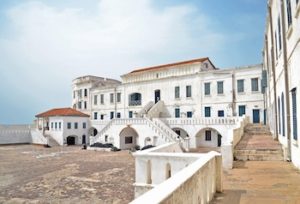
Fort William
*Fort William is affirmed on this date in 1753. This was a British slave-holding facility during the Middle Passage.
The Fort was in Anomabu, Central Region, Ghana. It was initially known as Fort Anomabo and renamed Fort William in the nineteenth century by its then-commander, Brodie Cruickshank, who added one level to the main building during King William IV's reign. The British built it after they prevented a French attempt to establish a fort at the same place.
Two earlier forts had been established at the same site, one in 1640 by the Dutch and another in 1674 (Fort Charles) by the English. Fort Charles was abandoned in 1730 and destroyed. In 1640, the Dutch built the first simple fort in the form of a stone nog and brick lodge. In 1653, the Swedes captured the lodge. In 1657, Danish forces took the lodge under Caerloff. In 1659 or 1660, the Dutch recaptured it. When the second Anglo-Dutch war ended in 1667 with the Treaty of Breda, the English gained a foothold in Anomabo.
In 1672 or 1673, the English began building Fort Charles, which was named after King Charles II of England, on the present-day site of Fort William. An early Anomabo chief, perhaps Eno or Eno Besi, inhabited the Dutch lodge at this time and declared it his palace. The English abandoned the fort to concentrate efforts and costs on Fort Carolusburg at Cape Coast Castle. In 1698, the Royal African Company "licensed" ship captains not in its employment upon paying a 10% "affiliation fee" to enable them to trade in its monopoly areas.
There followed a flood of "Ten Percenters" trading at British forts, often outnumbering the company's ships. Anomabu became a popular haunt of "ten percenters" (until their licensing was stopped in 1712), exporting vast numbers of slaves. In 1717, the Dutch director-general at Elmina, quoting an English captain on Anomabu slave trade exports, stated: "From January 1702 to August 1708, they took to Barbados and Jamaica [from Anomabu] a total of not less than 30,141 slaves and in this figure are not included transactions made for other ships sailing to such Islands as Nevis, Montserrat, St. Christopher, for the South Sea Company, the New Netherlands and others which would increase the above number considerably, and of which Annemaboe alone could provide about one third."
In 1753, after thwarting a French bid to establish a fort at Anomabu, the British began constructing Fort William, also known as Anomabu Castle, designed by military engineer John Apperly, who became its first governor. After Apperly died in 1756, white-Irishman Richard Brew took over the governorship of the fort and completed its construction in 1760. Fort William became the center of British slave trading along the Gold Coast until the slave trade was outlawed in 1807. Anomabu is a popular tourist destination. The well-preserved remains of Fort William can still be seen.